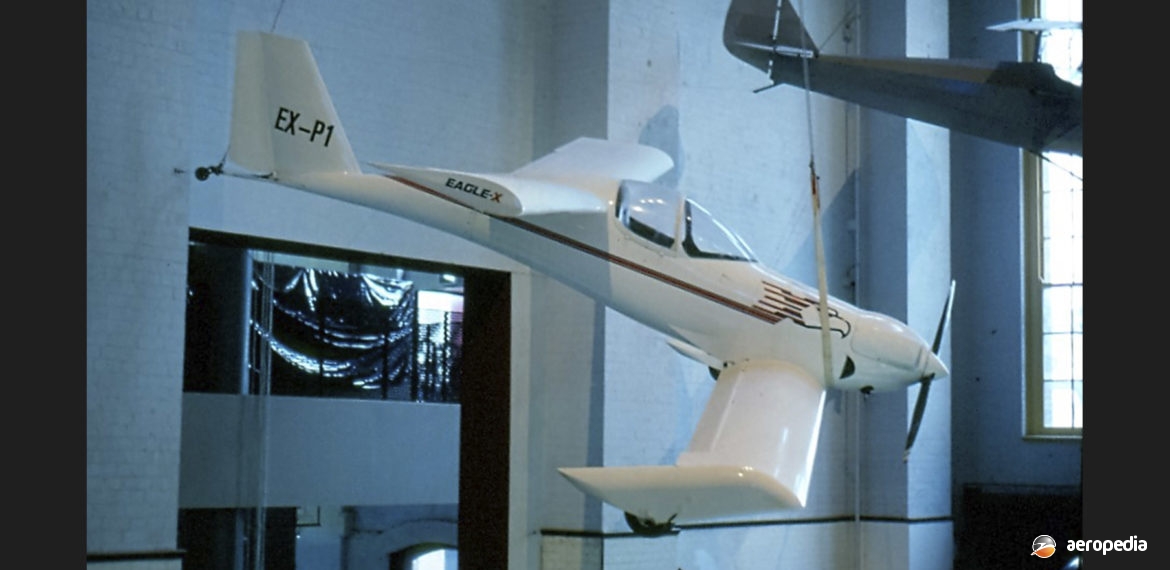Photograph:
Eagle Aircraft Eagle EX-P1 prototype on display at the Sydney Powerhouse Museum, NSW in 1991 (David C Eyre)
Country of origin:
Australia
Description:
Single-seat light sport and training aircraft
Power Plant:
One 37 kw (50 hp) Rotax two-cylinder two-stroke in-line air-cooled engine
Specifications:
- Wingspan: 4.87 m (16 ft)
- Length: 5.18 m (17 ft)
- Height: 1.2 m (3 ft 9 in)
- Max speed: 209 km/h (130 mph)
- Cruising speed: 185 km/h (115 mph)
- Range: 644 km (400 miles)
- Endurance: 3 hours
- Loaded weight: 200 kg (440 lb)
History:
Designed and developed by Composite Industries Ltd in Western Australia, the Eagle EX-P1 was considered to be the first designed and built all-composite aircraft completed in Australia. The EX-P1 was similar in appearance to the Quickie Aircraft series designed by Bert Rutan, its main requirements being that it should be a safe, intuitive aircraft in the hands of novice pilots, and forgiving of clumsy handling. It was classified as an ultralight to be registered under Recreational Aviation Australia (RAA) Regulations when they came into operation, but as demand for the aircraft in its single-seat form did not become popular at that time, the Company moved on to the Eagle XT-S, a two-seater aimed at the training and sport aircraft market.
A proof of concept prototype was built from composite materials, using carbon fibre and Kevlar, the results of testing of this aircraft leading to the XT-S two-seater with tricycle undercarriage. It was constructed by Eagle Aircraft, a subsidiary of Composite Industries Ltd, which was itself part of the Graham Group of Companies in Perth, WA. It was developed in response to what was perceived to be an interest from farming and mining communities for a cheap, reliable, easy and safe aircraft that could be operated with little maintenance.
Work on the project commenced in 1981 when the design parameters were placed in the hands of John Roncz who had been involved in the development of composites with Bert Rutan for light aircraft. The prototype first flew in 1984. However, on 30 January 1985, during test flying in hot and windy conditions, problems arose and the aircraft made a forced landing in a wheat field when the pilot was seeking to return to the airstrip at Cunerdin, WA causing substantial damage. The aircraft was later repaired.
The aircraft was also conceived as a transport for wealthy businessmen and was regarded by marketing management as an aerial ‘Sports car.’ It was also considered to be suitable for low altitude work, including aerial mustering and examination of farming properties from the air. As noted, it was classified as an ultralight, so did not require registration and a maintenance regime as would be required by a general aviation aircraft. However, there was always a reluctance of insurance companies to insure aircraft in this field and eventually, after moving to the production of the two-seat Eagle XT-S, the Company was purchased by Malaysian interests and Eagle Aircraft Company was formed to produce the aircraft as a basic trainer and private aircraft in Malaysia.
In 1987 the design received the ‘Best new product’ award from the “Australian Financial Review – AMEV Finance Ltd” and a prize was presented to the Company by the then Minister of Technology and Commerce at the Australian Financial Review New Product and Technology Expo at the Rose Hill race course function centre in western Sydney, NSW.
The canard EX-P1 monoplane was built in two parts, fuselage and tail, the exterior being covered in white gelcote with blue and red strips and an Eagle logo on the wing tip. It had an ovoid cockpit with a Perspex cover.
The aircraft was eventually donated to the Powerhouse Museum in Sydney, after being stored at Rose Hill for a period before being transferred in November 1987, and placed on display.

